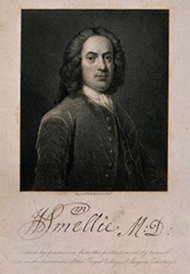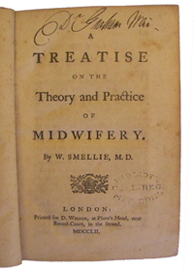Doctor William Smellie
William Smellie (1697-1763) is responsible for the introduction and the further development of midwifery forceps in the UK, and was also the most well known practitioner of midwifery instruction in London. In his ‘Treatise on the Theory and Practice of Midwifery” (1752) he was the first to describe the mechanism of normal labour, the rotation of the baby’s head with obstetrical forceps, and his application of the forceps to the head in breech deliveries1, many aspects of which are still used today. Smellie is one of the most prominent figures responsible for the initiation of obstetric teaching with simulated models in the UK.
Having started out as an apothecary and a surgeon, Smellie began his practice in Lanark in 1720, later moving to London to take up practice there. In 1733 Smellie became professionally qualified as a member of the Faculty of Physicians of Glasgow. It was at this time information was published by Edmund Chapman on the use of obstetrical forceps.
Smellie made a visit to Paris in 1739, where he watched M Grégoire at the Hotel Dieu teaching man-midwives the application of the forceps and demonstrating delivery positions using a manmade female model.2 He brought this innovation back with him to London and by 1741 he had begun teaching with his own version of dolls and ‘machine’. His courses were part of a marked revolution in medical education by which lectures were given privately and were open to anyone who could pay to take them; there were no prior requisites for attending. It is important to note that Smellie also taught women, although separately from men.3 ➡
NOTES | 1. O'Dowd, 1994 • 2. King, 2007 • 3. Drife, 2002
IMAGES | (top)
portrait of William Smellie courtesy of Wellcome Library, London
(bottom) frontispiece to William Smellies "Treatise on the Theory and Practice of Midwifery" courtesy of Royal College of Physicians of Edinburgh


